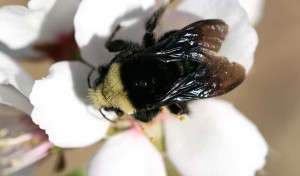
The California native bee species Bombus vosnesenskii, the yellow-faced bumble bee, forages on almond flowers that are located right next to rangelands habitat. (Alexandra Maria-Klein photo)
A recent study in Science magazine co-authored by Claire Kremen, highlights the importance of wild insects and bees in pollination and agriculture.
As reported on NPR:
A huge collaboration of bee researchers, from more than a dozen countries, looked at how pollination happens in dozens of different crops, including strawberries, coffee, buckwheat, cherries and watermelons. As they report in the journal Science, even when beekeepers installed plenty of hives in a field, yields usually got a boost when wild, native insects, such as bumblebees or carpenter bees, also showed up….
Claire Kremen, a conservation biologist at the University of California, Berkeley, who’s a co-author of the first study in Science, says one of the biggest problems for wild bees is the agricultural specialization that has produced huge fields of just one crop.
The almond groves of California, for example, are a sea of blossoms in February. It’s a feast, as far as the eye can see, for honeybees that come here from all over the country.
“But for the rest of the year, there’s nothing blooming,” she says.
Listen to, or read, the full NPR story here.
Meanwhile, the LA Times writes, Farmer’s Lack of Bees might be Solved by Going Wild.
“In some California orchards, the data showed that pollination by rented honeybees got a significant boost when wild bees were present, possibly because the wild insects prompted the hired guns to fly more frequently among different varieties of trees in an orchard, said Claire Kremen, a UC Berkeley conservation biologist who contributed to the study.
Read the full story — and see some amazing photos of wild bees — online at the LA Times.
